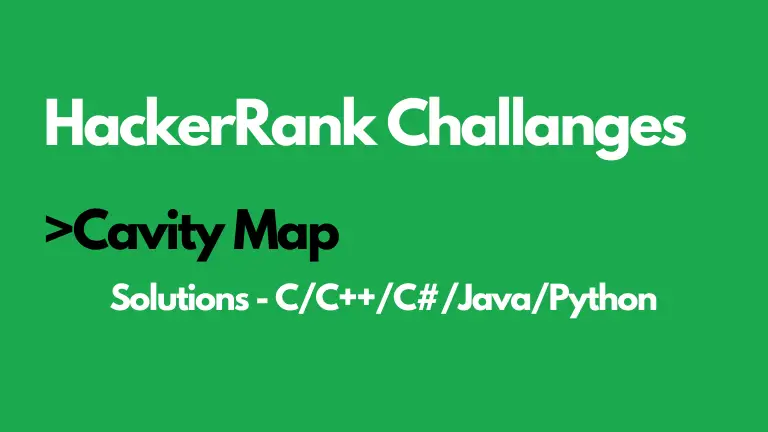You are given a square map as a matrix of integer strings. Each cell of the map has a value denoting its depth. We will call a cell of the map a cavity if and only if this cell is not on the border of the map and each cell adjacent to it has strictly smaller depth. Two cells are adjacent if they have a common side, or edge.
Find all the cavities on the map and replace their depths with the uppercase character X.
Example
grid=[‘989′,’191′,’111’]
The grid is rearranged for clarity:
989 191 111
Return:
989 1X1 111
The center cell was deeper than those on its edges: [8,1,1,1]. The deep cells in the top two corners do not share an edge with the center cell, and none of the border cells is eligible.
Function Description
Complete the cavityMap function in the editor below.
cavityMap has the following parameter(s):
string grid[n]: each string represents a row of the grid
Returns
string{n}: the modified grid
Input Format
The first line contains an integer , the number of rows and columns in the grid.
Each of the following lines (rows) contains positive digits without spaces (columns) that represent the depth at .
Sample Input
STDIN Function ----- -------- 4 grid[] size n = 4 1112 grid = ['1112', '1912', '1892', '1234'] 1912 1892 1234
Sample Output
1112 1X12 18X2 1234
Explanation
The two cells with the depth of 9 are not on the border and are surrounded on all sides by shallower cells. Their values are replaced by X.
Cavity Map HackerRank Solution in C
#include <stdio.h>
#include <string.h>
#include <stdbool.h>
#define clr(ar) memset(ar, 0, sizeof(ar))
#define read() freopen("lol.txt", "r", stdin)
int n;
int dx[] = {0, 0, -1, 1};
int dy[] = {-1, 1, 0, 0};
char str[1010][1010], res[1010][1010];
int main(){
int i, j, k;
while (scanf("%d", &n) != EOF){
for (i = 0; i < n; i++) scanf("%s", str[i]);
for (i = 0; i < n; i++){
for (j = 0; j < n; j++){
res[i][j] = str[i][j];
if (i == 0 || j == 0 || i == (n - 1) || j == (n - 1)) continue;
int max = -1;
for (k = 0; k < 4; k++){
int x = i + dx[k];
int y = j + dy[k];
if (str[x][y] > max) max = str[x][y];
}
if (max < str[i][j]) res[i][j] = 'X';
}
res[i][n] = 0;
}
for (i = 0; i < n; i++) puts(res[i]);
}
return 0;
}
Cavity Map HackerRank Solution in C++
#include <bits/stdc++.h>
using namespace std;
int N;
char grid[101][101];
char grid2[101][101];
int main()
{
scanf("%d\n", &N);
for(int i=0; i<N; i++)
gets(grid[i]);
memcpy(grid2, grid, sizeof grid2);
for(int i=1; i<N-1; i++)
for(int j=1; j<N-1; j++)
if(grid[i][j]>grid[i+1][j])
if(grid[i][j]>grid[i-1][j])
if(grid[i][j]>grid[i][j+1])
if(grid[i][j]>grid[i][j-1])
grid2[i][j]='X';
for(int i=0; i<N; i++)
puts(grid2[i]);
return 0;
}
Cavity Map HackerRank Solution in Java
import java.util.*;
class Solution
{
public static void main(String ar[])
{
Scanner in=new Scanner(System.in);
int n=in.nextInt(),i,j;
char c[][]=new char[n][];
for(i=0;i<n;i++)
{
c[i]=in.next().toCharArray();
}
for(i=1;i<n-1;i++)
{
for(j=1;j<n-1;j++)
{
if(c[i][j]>c[i][j-1] && c[i][j]>c[i][j+1] && c[i][j]>c[i-1][j] && c[i][j]>c[i+1][j])
c[i][j]='X';
}
}
for(i=0;i<n;i++)
System.out.println(new String(c[i]));
}
}
Cavity Map HackerRank Solution in Python
import sys
n = int(sys.stdin.readline())
m = []
for ix in range(n):
l = sys.stdin.readline()
if l[-1] == '\n':
l = l[:-1]
m.append([int(c) for c in l])
m2 = [[c for c in l] for l in m]
ds = [(-1, 0), (1, 0), (0, -1), (0, 1)]
for x in range(1, n - 1):
for y in range(1, n - 1):
v = m[x][y]
if all(map(lambda z: m[x + z[0]][y + z[1]] < v, ds)):
m2[x][y] = 'X'
for l in m2:
print ''.join(map(str, l))
Cavity Map HackerRank Solution in C#
using System;
using System.Linq;
public class Test
{
public static void Main()
{
// your code goes here
int n = int.Parse(Console.ReadLine());
int[,] num = new int[n,n];
for(int i = 0 ; i < n ; i++){
string str = Console.ReadLine().Trim();
for(int j = 0 ; j < n ; j++){
int x = int.Parse(str[j].ToString());
num[i,j] = x;
}
}
string output = string.Empty;
for(int i = 0 ; i < n ; i++){
output = string.Empty;
for(int j = 0 ; j < n ; j++){
if(i == 0 || j == 0 || i == n - 1 || j == n-1)
output += num[i,j];
else {
if(num[i-1,j] < num[i,j] && num[i+1,j] < num[i,j] && num[i,j+1] < num[i,j] && num[i,j-1] < num[i,j]){
output += "X";
}else{
output += num[i,j];
}
}
}
Console.WriteLine(output);
}
}
}
Attempt Cavity Map HackerRank Challenge
Link – https://www.hackerrank.com/challenges/cavity-map/
Next HackerRank Challenge Solution
Link – https://exploringbits.com/the-grid-search-hackerrank-solution/
Aayush Kumar Gupta is the founder and creator of ExploringBits, a website dedicated to providing useful content for people passionate about Engineering and Technology. Aayush has completed his Bachelor of Technology (Computer Science & Engineering) from 2018-2022. From July 2022, Aayush has been working as a full-time Devops Engineer.

